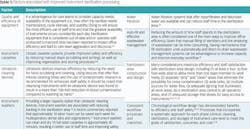Exploring the business advantages of efficient instrument processing
Infection control and sterilization are often at the forefront of dental patients’ minds and integral to their concept of quality health care.1-3 Patients’ growth in awareness of dental sterilization has been observed in recent years, most likely due to infection control breakdowns reported in the media. In fact, a recent analysis conveyed that patients’ attentiveness to the dental office environment and instrument cleanliness was affected and heightened following news reports of sterilization failures in dentistry.3
As practices are compelled to increase sterilization transparency and accountability, a dental office’s sterilization center has been proposed anecdotally as the “new glove” of dentistry.4 Given the importance of infection control, it is beneficial for dental practices to make a sound investment in sterilization equipment, and to maintain effective procedures that ensure a high level of proficiency and efficiency are followed. This article will (1) review best practices with instrument processing, (2) evaluate opportunities to improve time management and profitability, and (3) discuss the impact that instrument sterilization can have on patient/consumer satisfaction.
Efficiency and Saving Money
In the current dental care market, dentists are feeling pressure to increase production while preserving the safety of the patient. Innovation in dental processing equipment and methodology in instrument management provide today’s dental care teams with avenues to safer methods, which can lead to money saved thanks to improved efficiency.5 The majority of recommendations to improve instrument processing and prevent extra expense involve (1) automation, (2) updated equipment and agents, and (3) consistency in checklists/protocols for care teams. Factors associated with improving sterilization processes are given in Table 1.
Effective Use of the Dental Care Team
Instrument sterilization has been reported as one of the most labor-intensive areas of dental care sites.11 Effective management of staff time during instrument processing results in a positive impact on patient outcomes, improved experience of care, and a reduction of costs. The use of a sterilization manager or infection prevention coordinator provides sterilization proprietorship that can assist with staff and operational compliance, inventory management, and protocol development and implementation. It is beneficial to have policies and procedures for the entire dental team that highlight an appropriate workflow, establish goals, provide timelines for personnel training, hold teams accountable, and promote a culture of safety (figure 1). Doing so will result in improved efficiency and decrease staff frustration.5,16
Consumer Impact
Previous reports have analyzed service elements on which consumers placed higher expectations of dental care.17-19 Notably, the highest score awarded by patients surveyed was “clean and hygienic appearance” and “thorough sterilization of instruments,” which most patients regarded as crucial attributes.17 Undesirable events around infection control can impact patient choice and may result in negative information being posted online and quickly spread via social media. Negative reviews can affect the online ratings of dentists or dental care websites, which can lead to reduced revenue and lower patient utilization.20-21 Many practices are including sterilization areas in virtual tours on their websites and an abbreviated summary of their infection control processes. In addition, some dental practices are showing new patients the instrument processing area during first office visits, and biological testing results are being displayed in the front office area.
Conclusion
With recent media reports of infection control failures in the dental setting, awareness of infection control procedures has intensified. Sterilization is a main component of the patient experience and can impact patient utilization and satisfaction. With effective marketing and management, the sterilization process and instrument processing area can be important factors in both saving money and practice growth.
References
1. Five questions to ask your dentist about infection control. The Organization for Safety, Asepsis and Prevention website. http://www.osap.org/?Patient_FiveQuestion. Accessed March 23, 2017.
2. Burhenne M. 5 things to do at the dentist's office. CNN website. http://www.cnn.com/2013/03/29/health/dentist-5-things/. Published April 4, 2013. Accessed March 23, 2017.
3. Martinez TS, Hostetler J, Tjahjono J, Berenardo M. Parenting and dental care: Survey analysis of parental awareness and behaviors regarding children’s dental care and dental infection control. RDH website. http://www.rdhmag.com/articles/print/volume-35/issue-6/features/parenting-and-dental-care.html. Published June 12, 2015. Accessed March 23, 2017.
4. Amos J. The sterilization center, is it the new glove? Dentaltown website. http://howtoopenadentaloffice.com/sterilization-center/. Published October 23, 2014. Accessed March 23, 2017.
5. Cuny E, Bednarsh H. Instrument sterilization in dentistry. Dental Academy of CE website. https://www.dentalacademyofce.com/courses/1453/PDF/InstrumentSterilization.pdf. Accessed March 22, 2017.
6. Rani L, Pradeep D. Sterilization protocols in dentistry—a review. J Pharm Sci Res. 2016;8(6):558564.
7. Drevenstedt L. 8 ways to increase efficiency and reduce stress. Dental Economics website. http://www.dentaleconomics.com/articles/print/volume-97/issue-3/features/8-ways-to-increase-efficiency-and-reduce-stress.html. Published March 1, 2007. Accessed March 23, 2017.
8. Andrews N. Improving office efficiency. Incisal Edge. https://www.hu-friedy.com/products/index.php/mastercontrol/index/file/id/231. Published 2008. Accessed March 21, 2017.
9. Cafruny WA, Brunick A, Nelson DM, Nelson RF. Effectiveness of ultrasonic cleaning of dental instruments. Amer J Dent. 1995;8(3):152-156.
10. Molinari JA. Instrument washers not dishwashers. Dental Economics website. http://www.dentaleconomics.com/articles/print/volume-99/issue-6/columns/emerging-infection-control-challenges/instrument-washers-not-dishwashers.html. Published June 1, 2009. Accessed March 23, 2017.
11. Tholen M. Increase production and decrease expenses in sterilization. Dental Economics website. http://www.dentaleconomics.com/articles/print/volume-99/issue-10/features/increase-production-and-decrease-expenses-in-sterilization.html. Published October 1, 2009. Accessed March 23, 2017.
12. Braendle D. 5 ways to improve the efficiency of your sterilization center. SciCan Checklist. SciCan, 2017.
13. Midmark Corporation. Infection control in the dental practice through proper sterilization. http://www.midmark.com/docs/default-source/architectdesignercenter/dental/sterilization_packet.pdf. Accessed March 23, 2017.
14. Huter-Kunish GG. Processing loaner instruments in an ambulatory surgery center. AORN. 2009;89(5):861-870.
15. Improving quality and reducing cost in sterile processing department with Lean. Operational performance solutions. http://www.opsgroupinc.com/pdf/LeanSPDWhitePaper.pdf. Accessed March 23, 2017.
16. Kelsch NB, AS B. Team-centered approach to instrument processing and infection control. Dental Academy of CE website. https://www.dentalacademyofce.com/courses/3209/PDF/1611cei_Kelsch_web.pdf. Accessed March 23, 2017.
17. Chang WJ, Chang YH. Patient satisfaction analysis: Identifying key drivers and enhancing service quality of dental care. Journal of Dental Sciences. 2013;8(3):239-247.
18. Palihawadana D, Barnes BR. The measurement and management of service quality in dental healthcare. Health Serv Manage Res. 2004;17:229e36.
19. Karydis A, Komboli-Kodovazeniti M, Hatzigeiriou D, Panis V. Expectations and perceptions of Greek patients regarding the quality of dental health care. Int J Qual Health Care. 2001;13(5):409e16.
20. Luca M. Reviews, reputation, and revenue: The case of Yelp.com. Harvard Business School Working Paper, No. 12-016. http://www.hbs.edu/faculty/Publication%20Files/12-016_a7e4a5a2-03f9-490d-b093-8f951238dba2.pdf. Published September 2011. Accessed March 23, 2017.
21. Trehan SK, Daluiski A. Online patient ratings: why they matter and what they mean. The Journal of Hand Surgery. 2016;41(2):316-319.
Sean G. Boynes, DMD, MS, is the director of interprofessional practice at the DentaQuest Institute in Westborough, Massachusetts, overseeing national programs and initiatives focused on the integration and coordination of health care. A prolific speaker and author, he has been recognized by many organizations for his work in health policy and clinical care. He can be reached at [email protected].


